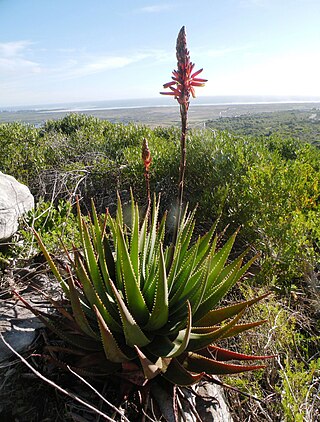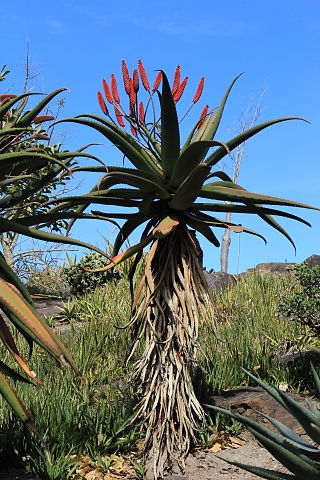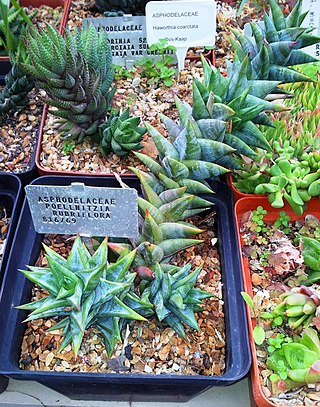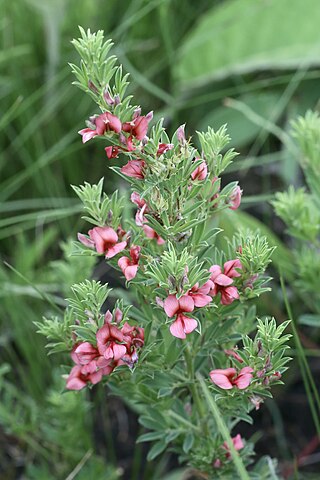
Haworthia is a large genus of small succulent plants endemic to Southern Africa (Mozambique, Namibia, Lesotho, Eswatini and South Africa).

Gonialoe variegata, also known as tiger aloe and partridge-breasted aloe, is a species of flowering plant in the family Asphodelaceae. It is an evergreen succulent perennial indigenous to South Africa and Namibia. It is common in cultivation.

Gasteria is a genus of succulent plants, native to South Africa and the far south-west corner of Namibia.

Aloe arborescens, the krantz aloe or candelabra aloe, is a species of flowering succulent perennial plant that belongs to the genus Aloe, which it shares with the well known and studied Aloe vera. The specific epithet arborescens means "tree-like". Aloe arborescens is valued by gardeners for its succulent green leaves, large vibrantly-colored flowers, winter blooming, and attraction for birds, bees, and butterflies.

Aloe succotrina, the Fynbos aloe, is an aloe which is endemic to Cape Town and the south-western corner of the Western Cape, South Africa.

Aloe polyphylla, the spiral aloe, kroonaalwyn, lekhala kharetsa, or many-leaved aloe, is a species of flowering plant in the genus Aloe that is endemic to the Kingdom of Lesotho in the Drakensberg mountains. An evergreen succulent perennial, it is well known for its strikingly symmetrical, five-pointed spiral growth habit.

Gonialoe sladeniana is a species of plant in the genus Gonialoe. It is endemic to arid areas of central Namibia.

Aloe maculata, the soap aloe or zebra aloe, is a Southern African species of aloe. Local people in South Africa know it informally as the Bontaalwyn in Afrikaans, or lekhala in the Sesotho language.

Aloe excelsa is an arborescent aloe indigenous to southern Africa.

Aloe ferox, commonly known as bitter aloe, is a species of flowering plant in the family Asphodelaceae. This woody aloe is indigenous to southern Africa. It is one of several Aloe species used to make bitter aloes, a purgative medication, and also yields a non-bitter gel that can be used in cosmetics.

Astroloba rubriflora is a succulent plant found in the mountainous Karoo area around Robertson, South Africa. It is listed as a Vulnerable species on the IUCN global Red List.

Aloe africana is an arborescent (tree-like) species of aloe plant, indigenous to the Eastern Cape Province, South Africa.

Aloiampelos commixta is a flowering plant in the Asphodelaceae family. It is commonly called Table Mountain aloe, and is a rare succulent plant that is endemic to the Cape Peninsula, South Africa. It naturally occurs only on the Table Mountain range, within the city of Cape Town.

Aloiampelos striatula, formerly Aloe striatula, the hardy aloe or striped-stemmed aloe, is a sturdy succulent plant that naturally occurs on the summits of mountains along the south of the Karoo region of South Africa. Tough and hardy, with bright yellow flowers, it is also cultivated as a garden ornamental.

Aloiampelos tenuior, formerly Aloe tenuior, the fence aloe, is a bushy, multi-branched succulent plant from the grasslands and thickets of the Eastern Cape, Kwazulu Natal and Mpumalanga, South Africa. Its preferred habitat is sandy soils in open country, unlike many of its relatives that favour thicket vegetation. It is one of the most profusely flowering of all aloes and their relatives.

Aloiampelos gracilis, formerly Aloe gracilis, the rocket aloe, is a succulent plant, endemic to dry thicket vegetation around the city of Port Elizabeth, South Africa. Its natural range lies just to the west of the related Aloiampelos ciliaris, and it occurs in bushy fynbos and dry thickets, and clustered on rocky outcrops at all altitudes. Its range extends westwards into the Baviaanskloof mountains.

Croton gratissimus, is a tropical African shrub or small tree with corky bark, growing to 8 m and belonging to the family of Euphorbiaceae or spurges. Young twigs are slender and angular and covered in silver and rust-coloured scales.

Aloe rupestris is an arborescent aloe indigenous to summer-rainfall areas of southern Africa.

Aloeae is a tribe of succulent plants in the subfamily Asphodeloideae of the family Asphodelaceae, consisting of the aloes and their close relatives. The taxon may also be treated as the subfamily Alooideae by those botanists who retain the narrower circumscription of Asphodelaceae adopted prior to the APG III system. Typically, plants have rosettes of more or less succulent leaves, with or without a distinct stem. Their flowers are arranged in racemes and tend to be either small and pale, pollinated by insects, or larger and more brightly coloured, pollinated by birds. As of 2017, 11 genera are recognized, most created since 2010 by splitting off another five genera from Aloe and another two from Haworthia. Only two genera, Aloe and Aloidendron, are native outside southern Africa, extending northwards to the Arabian Peninsula. Seven genera are restricted to South Africa, some with small ranges. Members of the Aloeae are cultivated by succulent plant enthusiasts; Aloe species especially are used in temperate climates as ornamental garden plants. Some species are used in traditional medicine. Aloe vera and Aloe ferox are cultivated for their extracts, whose uses include moisturizers and emollients in cosmetics.

Indigofera hilaris, the red bush indigo or gay indigofera, is a species of leguminous shrublet in the genus Indigofera.























